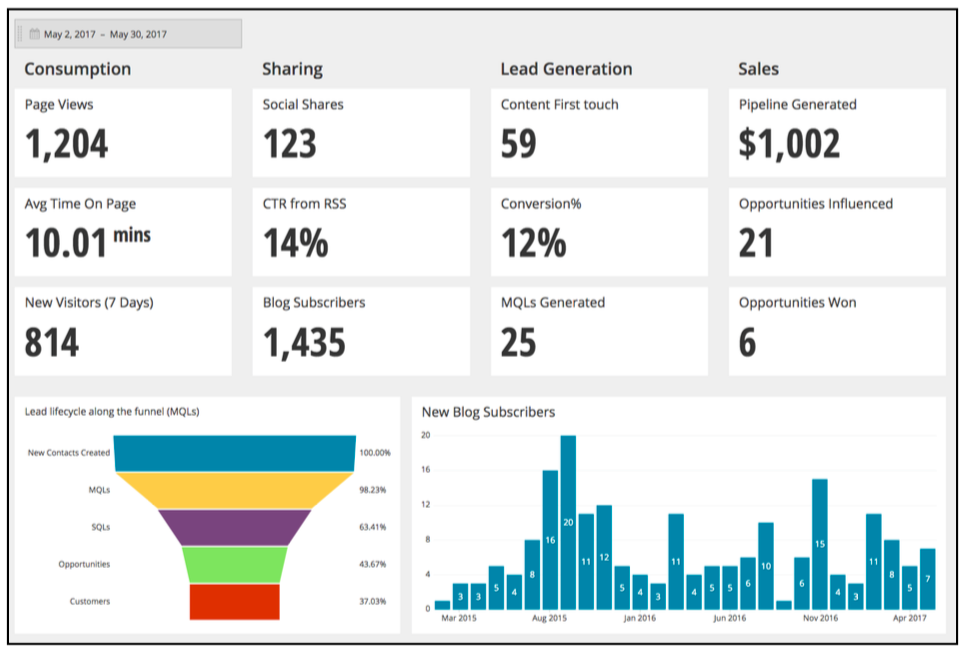How to Design the Ultimate Marketing Dashboard
Posted by on June 15, 2017 Marketing Analytics, Marketing, , Dashboards, Data Analytics
[Editor’s Note: This is our third installment in our “CMO’s Guide to Dashboards Blog Series.” In our previous installments, we highlighted today’s top marketing challenges and shared dashboard best practices around organization.]
According to a 2017 CMO Survey, only 31.6% of CMOs use analytics in their decision-making. While you might be ready to roll up your sleeves and start connecting your data sources and fire up a few charts, let’s take a step back first.
In our last blog post, How to Leverage Data to Create an Organized Marketing Dashboard, we shared best practices around dashboard organization. Now, we’re sharing best practices on the other side of the coin: design.
Marketing Dashboard Best Practices: Design
As dashboards become a standard of business, alongside organization is dashboard design. The impact of a thoughtfully designed dashboard is crucial to the consumption of information and quick insights.
We suggest focusing your design around two key areas: Audience and Layout.
Audience
Much like identifying your target market and audience, a dashboard also has a target audience. For a performance dashboard, the audience is the Executive team and your immediate marketing team.
-
CMO: From a high-level dashboard, you expect to get your numbers fast and be able to report out marketing performance based on your goals
-
Marketing team: With each member on the marketing team, they’ll probably manage their own dashboard. But, with a high-level dashboard, they’ll be able to understand how their individual performance fuels the overall marketing machine
-
VP of Sales: For true alignment between Sales and Marketing, share your dashboard with your Sales counterpart so he or she knows what’s coming up in their pipeline
-
CEO: Not only does the CEO need to know marketing performance, he or she will be able to share this dashboard with investors as they expect to see quarter-over-quarter growth for the company
When thinking about your target audience, we suggest running through a few questions:
-
Who is the consumer of this dashboard?
-
What value will the dashboard add?
-
What are the information needs of my audience?
-
What do they already know?
-
What type of dashboard am I creating?
-
What specific decisions does my audience need to make?
Understanding your audience, even if it’s multiple audiences, and crafting your dashboard to meet their expectations is critical in driving business decisions. Remember, dashboards should tell a story, and a performance dashboard should tell Marketing’s story.

An example of Content Marketing dashboard that shows the specific story of how content is performing over a given time frame.
Layout
We suggest letting the metrics and KPIs inform the layout of your performance dashboard. To streamline the thought process behind dashboard design best practices, we suggest working through the following framework:
Scope
-
Broad: display information about marketing efforts
-
Specific: focuses on a specific marketing discipline
Business Role
-
Strategic: provides a high-level, broad view
-
Operational: provides a focused view
Time Frame
-
Snapshot: shows performance at a specific point in time
-
Real-time: monitors activity as it happens, throughout a quarter
-
Predictive: uses past data to predict future performance
Granularity
-
High-level: showing only the most critical metrics
-
Drill down: showing detailed numbers to gain more context
Similar to layout, color plays an important role in dashboard consumption. Certain colors and chart types are more informative and easily digestible than others.
Craig Vigor of Verdensa Consulting says, “in terms of color, often times you want to make sure that you’re not presenting too many divergent, contrasting colors that will distract from the message.”
A few final things to consider when designing your dashboards:
-
What are the business implications of tracking these metrics?
-
How familiar are they with the metrics/KPIs?
-
Do they understand where the data comes from (do they need to know)?
-
What data sources does your dashboard need to connect to?
-
Will your audience benefit from interacting with the dashboard (drill downs)?
Conclusion
Dashboards aren’t easy. But when thoughtfully organized and designed, they’re meant to deliver value and drive business insights forward.
Stay tuned as we continue to explore the world of marketing dashboards on our blog. In our next blog post, we’ll share with your the must-have dashboards for your marketing team. For immediate action creating and leveraging robust dashboards, so you can track ROI, download our white paper, The CMO’s Guide to Dashboards.


